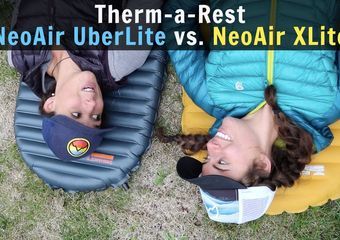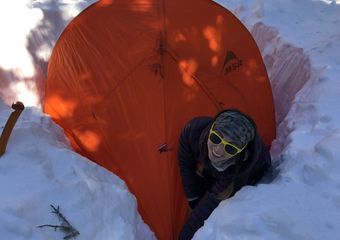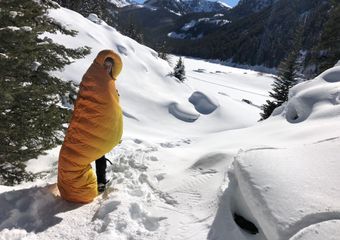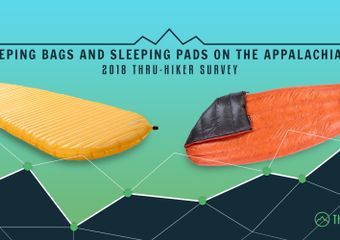Gear Review: Therm-a-Rest NeoAir XTherm Sleeping Pad
The Therm-a-Rest NeoAir XTherm is Therm-a-Rest’s warmest model in their wildly popular NeoAir sleeping pad line, which includes the NeoAir XLite and the new NeoAir Uberlite. With an R-value of 5.7 and a full-inflation thickness of 2.5 inches, this is a workhorse of a sleeping pad for winter camping or otherwise frigid conditions. This sleeping pad is just three ounces heavier than the XLite and takes up barely more space in the pack.
Therm-a-Rest NeoAir XTherm

Weight: 15 ounces (regular)
MSRP: $199
R-value: 5.7
Therm-a-Rest NeoAir XTherm Overview
As the warmest model in the NeoAir line, the XTherm speaks for itself. Just by taking into account the fact that the NeoAir line has cornered the thru-hiker market makes it an obvious option for anyone who needs a winter sleeping pad. The combination of packability, comfort, and low weight means campsites on long-distance trails are a veritable sea of NeoAirs. I’ve used models in the NeoAir line for the past four years, and adding the XTherm to my collection this year granted me the blessing of that four-season NeoAir Lyfe.
NeoAir XTherm Features

Baffled internal structure: The Triangular Core Matrix is a proprietary design from Therm-a-Rest found in the entire NeoAir line. These are stacked layers of triangular baffles that help create and maintain stability. They also help prevent heat loss without adding weight or bulk.
Reflective coating: Another proprietary design, the ThermaCapture layers on the shell fabric radiate body heat back to the sleeper, conserving both energy and warmth.
Tapered design: Instead of an actual rectangle, the XTherm tapers at the feet to save space and weight.
Durable, softer shell material: The face fabric is softer (and somewhat quieter) than in past models. It’s also stiffer than the XLite and UberLite.
NeoAir Notes
NeoAir XLite

Rolled size comparison, left to right: XTherm, XLite, UberLite. We’ll accept praise for managing to keep our feet out of photo.
Weight: 12 ounces
Thickness: 2.5 inches
R-Value: 3.2
MSRP: $170
Notes: The XLite is the original and most popular of the series. This is the most prevalent inflatable sleeping pad on the Appalachian Trail. It’s a great three-season pad that I’ve also used for winter camping. I’ve had some issues with keeping it inflated in super-cold temperatures, but it survived the entire AT and then some. It met its untimely demise thanks to my asshole cat, but I’ve since replaced it and had no issues whatsoever. The newest model of the XLite also has a quieter face fabric.
NeoAir Uberlite

Left to right: XTherm, XLite, UberLite
Weight: 8.8 ounces
Thickness: 2.5 inches
R-Value: 2
MSRP: $180
Notes: The UberLite is the newest and lightest of the NeoAir family. I tested this pad last summer and was blown away by how comfortable, warm, and small it is. However, on my fourth trip with the pad, I arrived at my destination to find that it wouldn’t stay inflated thanks to a nearly invisible seam / fabric failure. Therm-a-Rest was quick to repair it, but it didn’t make for a super comfortable trip on the desert floor. I’ll continue to use the UberLite this summer to make sure the repair holds. As with any ultralight item, you’ll have to be careful with this one. The packability and ounce-saving means the face fabric is thinner than the XLite and XTherm. Treat it well.
XTherm Warmth

Therm-a-Rest utilizes a reflective layer that helps return body heat to conserve and reuse what you’re already producing. Internal air pockets also help retain warmth thanks to the stacked Triangular Core Matrix that allows these pads to be lofty, protective, and exceptionally warm without fill or added weight. I used this sleeping pad in temperatures ranging from the mid 30s to below zero, in both dry and damp conditions. I never felt any conductive cold from the ground.
Durability
The face fabric is stiffer and thicker than the XLite or the UberLite, and I am confident in the durability of the fabric. I’ve had some seam issues on the other NeoAir, but haven’t experienced any failures with the XTherm this past season. It holds air throughout the night, and the valve seals easily.
Comfort
The pad is plenty wide for myself in my super-squishy sleeping bag, and the 2.5-inch thickness makes it comfortable for side, back, and stomach sleepers. It took me a few more breaths to inflate than the XLite or UberLite, but I was cold so maybe I was more wheezy than normal?
Who will need a sleeping pad this warm?

This cold-weather-optimized pad is ideal for hikers who travel fast and light even in winter conditions. If you are taking on an off-season long-distance hike where you’ll be camping in below-freezing temperatures or on frozen ground, you’ll want a sleeping pad with an R-value of at least 4. A sleeping pad with an R-value of 5.7 pretty much guarantees comfort and insulation in temperatures falling below zero degrees Fahrenheit. If you won’t be spending a lot of time in winter conditions, the XLite will serve you well. I’ve camped in the 20s-30s plenty of times with a sleeping pad with an R-value in the 3s and have been fine with a warm sleeping bag.
Pros
One of the most impressive warmth-to-weight ratios of any piece of gear I own. True to the rest of the line, the thickness provides ample protection from hard and rocky ground, and I can sleep perfectly comfortably on my side. It’s plenty large for moving around at night, and packs down incredibly small. The thicker face fabric feels stable, and the pad has not lost air on me overnight.
Cons
Not a lot. It’s bulkier than the other models in the NeoAir line, but you can’t count it against a pad with a 5.7 R-value. It was somewhat slippery against the material of the tent floor, something I’ve experienced with the XLite and the UberLite as well.
Overall

Hikers looking for a lightweight, compact cold-weather sleeping pad should look no further. The XTherm packs down to the size of a Nalgene, is durable, protective, and extremely comfortable for all types of sleepers. The reflective surface and internal baffles retain heat without bulk, and you can be confident taking this out on winter excursions. It’s also not so huge that you’d feel dumb taking it on three-season outings either, so if you just want one sleeping pad and want the extra protection of the XTherm, it’s a solid option.
Related
This item was donated for purpose of review
This website contains affiliate links, which means The Trek may receive a percentage of any product or service you purchase using the links in the articles or advertisements. The buyer pays the same price as they would otherwise, and your purchase helps to support The Trek's ongoing goal to serve you quality backpacking advice and information. Thanks for your support!
To learn more, please visit the About This Site page.







